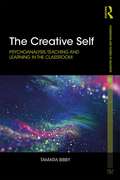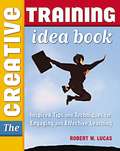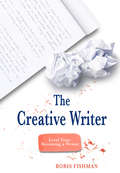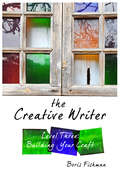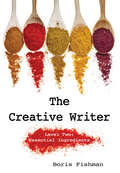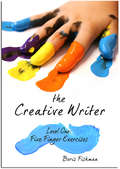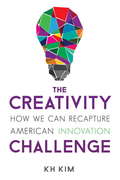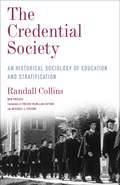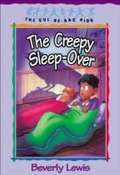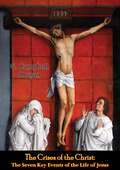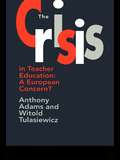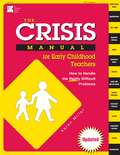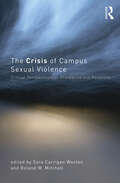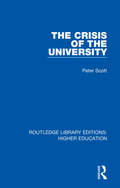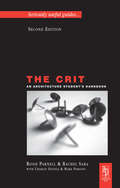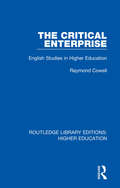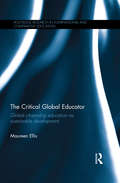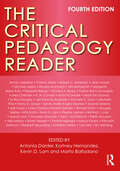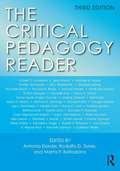- Table View
- List View
The Creative Self: Psychoanalysis, Teaching and Learning in the Classroom (Foundations and Futures of Education)
by Tamara BibbyThe Creative Self engages with the work of the psychoanalyst D.W. Winnicott to develop alternative ways of thinking about key issues at the heart of pedagogy; specifically pedagogic relationships, creativity, defiance and compliance. These issues underpin the desires and defences of professionals located in educational institutions, such as the desire to know what is best, to know how to reach all learners, normalised expectations of behaviours and outcomes, and sometimes challenging engagements with students and the curriculum. Each chapter provides both a theoretical focus and illustrative demonstrations of the ways in which Winnicott’s theories may be relocated and used productively as tools for professional and academic reflexivity. By building extensively on Winnicott’s understanding of the ways in which relationships facilitate (or hinder) the development of the self, this book extends his clinical focus on parental and analytical relationships to think about the ways in which the pedagogic relationship can provide an environment in which people may (or may fail to) develop as learners. This approach provides powerful ways of thinking about pedagogy and pedagogic relationships that stand apart from the cognitive and rationalist tradition. This focus can be used constructively to support people working in educational settings to re-establish a sense of personal and professional autonomy in an environment recently typified by compliance. The Creative Self is an engaging and innovative read appealing to postgraduate students, teachers, researchers and academics with a desire for a new analytic lens through which to explore the educational experiences of both learners and teachers in schools, colleges and universities.
The Creative Training Idea Book: Inspired Tips and Techniques for Engaging and Effective Learning
by Robert W. LucasTrainers have to be creative if they want their participants to feel excited, challenged, and involved. The Creative Training Idea Book is packed with instructions for using activities, games, puzzles, toys, and props to increase energy and active participation in the classroom, and reveals how to think creatively about training in any situation.Based on the author’s nearly three decades of training experience, this invaluable resource gives trainers the tools to adopt a fun, energetic approach that will make for a stimulating learning environment. Readers will learn new methods for:* setting the right tone* uncovering participant needs* grouping participants and selecting leaders* avoiding and reclaiming turned-off learners* encouraging and rewarding participation* and much more!Filled with checklists, forms, resources, and dozens of ""Bright Idea"" blurbs, The Creative Training Idea Book will help trainers and their learners achieve maximum learning results.
The Creative Writer, Level Four (The Creative Writer)
by Boris FishmanThe culminating volume in the four-book series that guides students into the creation of sophisticated short fiction and mature poetry. Building on the skills taught in the first three levels, The Creative Writer, Level Four: Becoming a Writer guides young writers from idea to polished short story or poem in a single volume. Becoming a Writer also walks students through the transition from study to practice, broadening the series' focus by discussing the writing life -- how to find and submit to literary journals, how to develop discipline, and how to persevere in the face of rejection. Reviews and strengthens the writer's grasp on the five essentials of fiction: plot, character, dialogue, point of view, and setting. Guides the writer into the effective, sophisticated use of the essentials of poetry: sound, rhythm, word choice, and structure. All exercises build toward the production of mature, finished creative piece Can be used as a complement to Writing With Skill or on its own.
The Creative Writer, Level Three: Building Your Craft (The Creative Writer)
by Boris FishmanThe third volume of the four-book series that guides students into the creation of sophisticated short fiction and mature poetry. * Complements Peace Hill Press's expository series Writing With Skill by providing the imaginative element that many students want. * Unlike most "how to write" books, these are designed to be used in a mentor/student relationship, with teaching, guidance, and evaluation tips provided for the mentor or teacher. * All exercises build towards the production of finished creative pieces * Sequential, logical, step-by-step instruction * The third level builds on the introductory volume, The Creative Writer: Five Finger Exercises, but can be started directly by older students. * Instruction in the five essentials of fiction: plot, characters, dialogue, point of view, and setting. Level Three leads students into the construction of more complex plots, evocative settings, and three-dimensional characters * Guidance in the essential art of poetry: sound, rhythm, word choice, and poem construction. Level Three draws students into even more sophisticated use of words and themes.
The Creative Writer, Level Two: Essential Ingredients (The Creative Writer)
by Boris FishmanThe second volume of the four-book series that guides students into the creation of sophisticated short fiction and mature poetry. Complements Peace Hill Press's expository series Writing With Skill by providing the imaginative element that many students want. Unlike most "how to write" books, these are designed to be used in a mentor/student relationship, with teaching, guidance, and evaluation tips provided for the mentor or teacher. All exercises build towards the production of finished creative pieces. Sequential, logical, step-by-step instruction. The second level builds on the introductory volume, The Creative Writer: Five Finger Exercises, but can be started directly by older students. Instruction in the five essentials of fiction: plot, characters, dialogue, point of view, and setting. Offers guidance in the essential art of poetry: sound, rhythm, word choice, and poem construction.
The Creative Writer: Five Finger Exercises (The Creative Writer)
by Boris FishmanA gentle, imaginative introduction to the skills all creative writers need. Breaking down the elements that go into successful imaginative works, The Creative Writer leads aspiring writers through the skills needed to construct each. The assignments, designed to make students more aware of language and more confident in their own ingenuity, build on each other until beginning creative writers have successfully created their own stories, poems, and essays. * Simple but innovative exercises encourage young writers to strengthen their vocabulary and become aware of the patterns of sentences * Legends and folklore are used to teach point of view, characterization, plotting, and other vital skills * Classic poetry serves as a model for the student's own original poems * Unlike most "how to write" books, The Creative Writer is designed to be used in a mentor/student relationship, with teaching, guidance, and evaluation tips provided for the mentor or teacher * Can be used as a complement to Writing With Skill or on its own
The Creativity Challenge: How We Can Recapture American Innovation
by Kh KimAmerican creativity has steadily declined since 1990. That disturbing trend recently came to light through the work of leading educational psychologist KH Kim, a recognized expert in creativity assessment. In this insightful and inspiring book, Kim discovers the causes of the decrease in creativity and proposes methods of recapturing American creativity in education, in industry, and throughout every sector of society. Through the life stories of innovators, Kim debunks the assumption that creative people must be born with innate talents. She shows how parents, educational methods, and cultures shaped innovators' creative expression. As her research clearly indicates, cultural climates and attitudes (including over-reliance on standardized testing) often work against innovation unless creativity is deliberately grown and developed. Culminating over twenty years of extensive research, Kim has devised original models to identify creativity in people and organizations and help it to blossom. Gardening metaphors illustrate simple but powerful steps to transform creative potential into innovation. She emphasizes practical steps to cultivate creative climates (environment) in schools, in homes, and at work; nurture creative attitudes (personality) toward learning, work, and life; and apply creative thinking skills. Kim's models for creativity are complemented with evidence-based methods to learn and practice creative skills in everyday life.From the Trade Paperback edition.
The Creativity Leap: Unleash Curiosity, Improvisation, and Intuition at Work
by Natalie Nixon"Natalie Nixon's new book provides a fresh primer on how to cultivate creativity in the workplace.&” —Nir Eyal, bestselling author of Hooked and IndistractableToo many people associate creativity solely with the arts, even though to be an incredible scientist, engineer, or entrepreneur requires immense creativity. And it's the key to developing breakthrough products and services. Natalie Nixon, a creativity strategist with a background in cultural anthropology, fashion, and service design, says that in the fourth industrial revolution a creativity leap is needed to bridge the gap that exists between the churn of work and the highly sought-after prize called innovation.Nixon says that since humans are hardwired to be creative, it is a competency anyone can develop. She shows that it balances wonder (awe, audacity, and curiosity) with rigor (discipline, skill-building, and attention to detail), and that inquiry, improvisation, and intuitionare the key practices that increase those capacities. Drawing on interviews with fifty-six people from diverse backgrounds—farming, law, plumbing, architecture, perfumery, medicine, education, technology, and more—she offers illuminating examples of how creativity manifests in every kind of work. Combining creativity tools and techniques with real-world stories of innovative people and businesses, this book is a provocation, an inspiration, and an invitation to unleash the innate creativity that lies within each of us. It offers a more dynamic and integrative way to adapt and innovate, one that allows us the freedom to access our full human selves.
The Creature Garden: An Illustrator's Guide to Beautiful Beasts & Fictional Fauna
by Harry Goldhawk Zanna GoldhawkAn illustrator’s step-by-step sourcebook for drawing and painting fifty real and imagined creatures in a whimsical folk-art style. Husband-and-wife illustrator team Harry and Zanna Goldhawk, founders of Papio Press, teach you how to make vibrant drawings and paintings of these beautiful beasts and fictional fauna:Mammals, including big cats, wolves, sloths, and red pandasMarine life, including whales, sea dragons, narwhals, and giant Pacific octopiBirds, including peacocks, cranes, owls, and flamingosInsects, including butterflies, moths, bumblebees, and damselfliesMythical creatures, including mermaids, unicorns, dragons, phoenixes, centaurs, and hippogriffsand more!The Creature Garden begins with the basics, first instructing you on which tools to use, how to create patterns, the importance of keeping a sketchbook, and even avoiding comparison with other artists. The book then navigates through each illustration in a step-by-step manner that is manageable and easy to understand. Each project carefully guides you through each phase of the artistic process, from creating an outline to adding a realistic animal pattern.You’ll also learn how to draw botanical patterns from different environments—the garden, forest, jungle, and ocean—that enable you to surround your animal drawings with a natural environment. Full of lush warmth and fairy-tale wonder, The Creature Garden is a wonderful addition to the repertoire of both seasoned artists and novices alike.
The Credential Society: An Historical Sociology of Education and Stratification (Legacy Editions)
by Randall CollinsThe Credential Society is a classic on the role of higher education in American society and an essential text for understanding the reproduction of inequality. Controversial at the time, Randall Collins’s claim that the expansion of American education has not increased social mobility, but rather created a cycle of credential inflation, has proven remarkably prescient.Collins shows how credential inflation stymies mass education’s promises of upward mobility. An unacknowledged spiral of the rising production of credentials and job requirements was brought about by the expansion of high school and then undergraduate education, with consequences including grade inflation, rising educational costs, and misleading job promises dangled by for-profit schools. Collins examines medicine, law, and engineering to show the ways in which credentialing closed these high-status professions to new arrivals. In an era marked by the devaluation of high school diplomas, outcry about the value of expensive undergraduate degrees, and the proliferation of new professional degrees like the MBA, The Credential Society has more than stood the test of time. In a new preface, Collins discusses recent developments, debunks claims that credentialization is driven by technological change, and points to alternative pathways for the future of education.
The Creed in Slow Motion: An exploration of faith, phrase by phrase, word by word
by Martin KochanskiI believe in one God, the Father almighty, maker of heaven and earth...The Creed is the bones of our faith. In all our different ways, it makes us who we are. But when we stand up and recite the Creed in unison, we have no time to contemplate what it is that we are committing ourselves to. The words rush past, their meaning blurred by familiarity. If we could only slow them down and hear them properly, they would have the power to change worlds. That is what The Creed in Slow Motion aims to do. This is a book for people who like to think things through from first principles. It will not tell you what to believe. (It is for you to engage your mind and discover that for yourself. And for unbelievers to learn what exactly they disbelieve, and why.)In forty short chapters, with clarity and wit, The Creed in Slow Motion draws examples from real-life stories, history and even science to uncover the core claims of Christianity. By turns it is deep, heartening, startling, revolutionary and even, by the world's standards, outrageous.
The Creed in Slow Motion: An exploration of faith, phrase by phrase, word by word
by Martin KochanskiI believe in one God, the Father almighty, maker of heaven and earth...The Creed is the bones of our faith. In all our different ways, it makes us who we are. But when we stand up and recite the Creed in unison, we have no time to contemplate what it is that we are committing ourselves to. The words rush past, their meaning blurred by familiarity. If we could only slow them down and hear them properly, they would have the power to change worlds. That is what The Creed in Slow Motion aims to do. This is a book for people who like to think things through from first principles. It will not tell you what to believe. (It is for you to engage your mind and discover that for yourself. And for unbelievers to learn what exactly they disbelieve, and why.)In forty short chapters, with clarity and wit, The Creed in Slow Motion draws examples from real-life stories, history and even science to uncover the core claims of Christianity. By turns it is deep, heartening, startling, revolutionary and even, by the world's standards, outrageous.
The Creepy Sleep-Over
by Beverly LewisDunkum Mitchell's imagination kicks into high gear when he and seven classmates sleep over at Miss Hershey's house. Creepy sounds and weird shadows keep Dunkum wide-eyed and wanting to go home--until crazy Jason Birchall comes up with a better idea!
The Crime of Reason: And the Closing of the Scientific Mind
by Laughlin Robert B.We all agree that the free flow of ideas is essential to creativity. And we like to believe that in our modern, technological world, information is more freely available and flows faster than ever before. But according to Nobel Laureate Robert Laughlin, acquiring information is becoming a danger or even a crime. Increasingly, the really valuable information is private property or a state secret, with the result that it is now easy for a flash of insight, entirely innocently, to infringe a patent or threaten national security. The public pays little attention because this vital information is "technical”--but, Laughlin argues, information is often labeled technical so it can be sequestered, not sequestered because it’s technical. The increasing restrictions on information in such fields as cryptography, biotechnology, and computer software design are creating a new Dark Age: a time characterized not by light and truth but by disinformation and ignorance. Thus we find ourselves dealing more and more with the Crime of Reason, the antisocial and sometimes outright illegal nature of certain intellectual activities. The Crime of Reason is a reader-friendly jeremiad, On Bullshit for the Slashdot and Creative Commons crowd: a short, fiercely argued essay on a problem of increasing concern to people at the frontiers of new ideas.
The Crises of the Christ: The Seven Key Events of the Life of Jesus
by G. Campbell MorganThe Crises of the Christ: The Seven Key Events of the Life of Jesus by G. Campbell Morgan offers a profound exploration of pivotal moments in the life and ministry of Jesus Christ. With his characteristic depth and clarity, Morgan—renowned preacher, Bible scholar, and pastor—delves into the significance of these defining events, illuminating how they reveal Christ’s mission, identity, and purpose within God’s redemptive plan.Morgan structures the book around seven key “crises” in Christ’s earthly life, beginning with the Incarnation and culminating in the Resurrection and Ascension. Each chapter examines one of these turning points, which include His birth, baptism, transfiguration, crucifixion, resurrection, and more. Morgan provides rich theological reflections on these events, offering fresh insights into how they shaped Jesus’ ministry and the spiritual destiny of humanity.With keen attention to Scripture, Morgan emphasizes how each crisis was not merely an external event but a moment of deep spiritual importance that confronted both Christ and His followers with crucial decisions. These crises highlight the unfolding revelation of who Jesus is—fully God and fully man—and demonstrate the gravity of His mission to reconcile humanity with God.Throughout the book, Morgan connects these key events to the broader narrative of salvation history, showing how they collectively unveil the heart of the Gospel. His reflections encourage believers to respond to Christ’s life and sacrifice with faith, obedience, and personal transformation.The Crises of the Christ remains a timeless work for readers seeking a deeper understanding of the life of Jesus and the core events that define Christianity. Ideal for personal study, pastoral teaching, or devotional reflection, this book continues to inspire believers to engage with the life of Christ not just as history but as the ultimate revelation of God’s love and purpose for humanity.
The Crisis In Teacher Education: A European Concern?
by Anthony Adams Witold TulasiewiczTeacher education is continually undergoing change and this book takes a close look into the current status. It examines the history of teacher preparation, the role of the employer and the aims of education, giving a critical review of the present climate where changes in several European countries are underway. They address the question of why the changes are being made now and conclude that such changes, particularly in the UK, are ideological as opposed to quality-based.; New proposals and legislation in the European Unions countries of Britain, France, Germany and Portugal are considered, from a comparative perspective, alongside Poland and the United States; the latter also experiencing change but for different reasons.; Aimed at all readers interested in the role of education in Europe, this text should also appeal to students and lecturers in education in Europe, and to the informed general reader interested in the state of education today.
The Crisis Manual for Early Childhood Teachers: How to Handle the Really Difficult Problems
by Karen MillerThe only source book you'll need to face those really difficult issues in the classroom. Learn effective strategies for addressing the most challenging problems you may encounter as a teacher, such as the death of a family member, domestic violence, substance abuse, sex abuse, homelessness, natural disasters and children with HIV/AIDS. Chapters for each crisis include describing the problem, insights from child development, when to seek help, how to respond, and suggestions of organizations and individuals you can turn to for help.
The Crisis of Campus Sexual Violence: Critical Perspectives on Prevention and Response
by Sara Carrigan Wooten Roland W. MitchellAlthough awareness of campus sexual assault is at a historic high, institutional responses to incidents of sexual violence remain widely varied. The Crisis of Campus Sexual Violence provides higher education scholars, administrators, and practitioners with a necessary and more holistic understanding of the challenges that colleges and universities face in implementing adequate and effective sexual assault prevention and response practices. In this volume, a diverse mix of expert contributors provide a critical, nuanced, and timely examination of some of the factors that inhibit effective prevention and response in higher education. Chapter authors take on one of the most troubling aspects of higher education today, bridging theory and practice to offer programmatic interventions and solutions to help institutions address their own competing interests and institutional culture to improve their practices and policies with regard to sexual violence.
The Crisis of the University (Routledge Library Editions: Higher Education #25)
by Peter ScottOriginally published in 1984, The Crisis of the University looks at the way in which changes to intellectual life relate to the development of the different institutions that make up higher education. It examines the evolution of the liberal university that flourished in the 19th and early 20th centuries into the modern university that has grown up since 1945. It also looks at the more detailed experience of British higher education, with separate chapters on what the Robbins expansion meant for the universities and why it was thought necessary to construct an alternative in the shape of the polytechnics. Looking to the future, the book argues first that the present structure of British higher education needs reform and speculates on the future intellectual and social demands that may be made of higher education.
The Crit: An Architecture Student's Handbook
by Rachel Sara Charles Doidge Rosie ParnellThe architectural crit, review or jury is a cornerstone of architectural education around the world. The defence of ideas, drawings, and models in an open format before staff and peers is intended to be a foreground for healthy creative debate, but many students view it as hostile confrontation – an ego trip for staff and humiliation for them. This accessible and immensely enjoyable book guides students through this academic minefield.This fully updated edition includes advice and suggestions for tutors on how to model a crit around a broad range of learning styles, as well as a new section aimed at students with learning disabilities, to ensure that the process is constructive and beneficial for all architecture and design scholars. Packed with practical tips from tutors, students and professionals, this reassuringly honest book will prepare students to build more creative relationships with clients and users across the industry. Also in the Seriously Useful Guides series:* Practical Experience* The Dissertation* The Portfolio
The Critical Enterprise: English Studies in Higher Education (Routledge Library Editions: Higher Education #5)
by Raymond CowellOriginally published in 1975, The Critical Enterprise looks at how the expansion and diversification of English Studies was shaping and was shaped by the Higher Education curriculum. The book looks at how students of sixth forms, colleges, polytechnics and universities alike found an increasing emphasis on interdisciplinary studies and how this opened new ways of studying new subjects. The book defines the unique academic elements which make English Studies a unique academic experience as well as an essential ingredient of most interdisciplinary courses.
The Critical Global Educator: Global citizenship education as sustainable development (Routledge Research in International and Comparative Education)
by Maureen EllisAn acknowledged challenge for humanitarian democratic education is its perceived lack of philosophical and theoretical foundation, often resulting in peripheral academic status and reduced prestige. A rich philosophical and theoretical tradition does however exist. This book synthesises crucial concepts from Critical Realism, Critical Social Theory, Critical Discourse Studies, neuro-, psycho-, socio- and cognitive-linguistic research, to provide critical global educators with a Cultural Historical Activity Theory (CHAT) framework for self- and negotiated evaluation. Empirical research spanning six years, involving over 500 international teachers, teacher educators, NGO and DEC administrators and academics, traces the personal and professional development of the critical global educator. Analyses of surveys, focus groups and interviews reveal factors which determine development, translating personal transformative learning to professional transaction and transformational political efficacy. Eight recommendations call for urgent conceptual deconstruction, expansion and redefinition, mainstreaming Global Citizenship Education as Sustainable Development. In an increasingly heteroglossic world, this book argues for relevance, for Critical Discourse Studies, if educators mediating and modelling diverse emergent disciplines are to honestly and effectively engage a learner’s consciousness. The Critical Global Educator will appeal to researchers, academics and postgraduate students in the fields of citizenship, development, global education, sustainability, social justice, human rights and professional development.
The Critical Merits of Young Adult Literature: Coming of Age
by Crag HillThis examination of the literary effectiveness of young adult literature from a critical, research-oriented perspective answers two key questions asked by many teachers and scholars in the field: Does young adult literature stand up on its own as literature? Is it worthy of close study? The treatment is both conceptual and pragmatic. Each chapter discusses a topical text set of YA novels in a conceptual framework—how these novels contribute to or deconstruct conventional wisdom about key topics from identity formation to awareness of world issues, while also providing a springboard in secondary and college classrooms for critical discussion of these novels. Uncloaking many of the issues that have been essentially invisible in discussions of YA literature, these essays can then guide the design of curriculum through which adolescent readers hone the necessary skills to unpack the ideologies embedded in YA narratives. The annotated bibliography provides supplementary articles and books germane to all the issues discussed. Closing "End Points" highlight and reinforce cross-cutting themes throughout the book and tie the essays together.
The Critical Pedagogy Reader
by Antonia Darder Kortney Hernandez Kevin D. Lam Marta BaltodanoSince its publication, The Critical Pedagogy Reader has firmly established itself as the leading collection of classic and contemporary essays by the major thinkers in the field of critical pedagogy. While retaining its comprehensive introduction, this thoroughly revised fourth edition includes updated section introductions, expanded bibliographies, and up-to-date classroom questions. The book is arranged topically around such issues as class, racism, gender/sexuality, language and literacy, and classroom issues for ease of usage and navigation. New reading selections cover topics such as youth activism, agency and affect, and practical implementations of critical pedagogy. Carefully attentive to both theory and practice, this new edition remains the definitive source for teaching and learning about critical pedagogy.
The Critical Pedagogy Reader (Third Edition)
by Rodolfo D. Torres Antonia Darder Marta P. BaltodanoFor fifteen years, The Critical Pedagogy Reader has established itself as the leading collection of classic and contemporary essays by the major thinkers in the field of critical pedagogy. While retaining its comprehensive introduction, this thoroughly revised third edition includes updated section introductions, expanded bibliographies, and up-to-date classroom questions. The book is arranged topically around issues such as class, racism, gender/sexuality, critical literacies, and classroom issues, for ease of usage and navigation. New to this edition are substantive updates to the selections of contemporary readings, including pieces that reflect issues such as immigrant and refugee students, the role of social justice in teacher education, and an emphasis on practical elements of pedagogy, as well as it significance to forging democratic life. Carefully attentive to theory and practice, this much-anticipated third edition remains the definitive, foundational source for teaching and learning about critical pedagogy.
